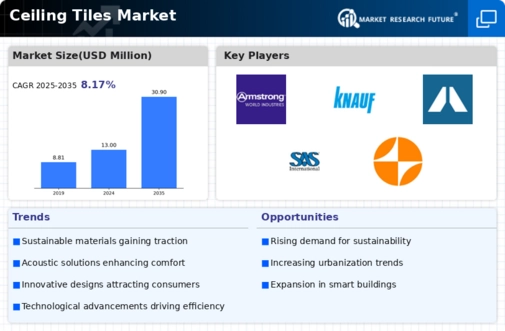Market Analysis
In-depth Analysis of Ceiling Tiles Market Industry Landscape
Styles in architecture and interior design have a huge effect on how markets work. Different builders, designers, and end users have different tastes that affect the demand for different ceiling tile styles, materials, and finishes. This makes the market more open to new ideas and flexible. New ceiling tile materials and ongoing innovation help to change the market. When new materials come out, they improve the sound quality, and when new design options come out, they change what people choose, which forces companies to stay on top of material research and product development. Increasing focus on safety and environmental issues is a market driver. To meet the needs of customers who care about the environment, companies that make ceiling tiles need to use recovered materials and sustainable production methods. Regulatory rules and legal requirements shape how markets work. Following rules about safety, quality, and the environment is very important. Changing standards can affect how things are made, what they are made of, and how the market works as a whole. The increase in business building projects is very important to the way the market works. Many businesses, like offices, shops, and restaurants, use ceiling tiles. Changes in the activity in commercial buildings have a direct effect on the market. Connecting technologies and using Industry 4.0 methods change how markets work. A lot of changes are happening in the ceiling tile business because of automation, digitization, and smart technologies. These technologies are making the supply chain management and manufacturing processes more efficient and quick to respond. Price changes for raw materials affect how the market works. Changes in the prices of materials like gypsum, mineral fiber, or metal have a direct effect on the costs of making ceiling tiles. This has an effect on their prices and how competitive they are in the market. The way the market works is affected by how important sound performance is becoming in building design. Building goals are changing quickly, as more sound-absorbing ceiling tiles are in high demand in a wide range of settings, such as businesses, schools, and hospitals. Adopting digital marketing and making a web footprint are big changes in the market. When businesses use digital media for marketing and sales properly, they reach more customers and get more publicity, which changes the way markets work in the digital age.








Leave a Comment